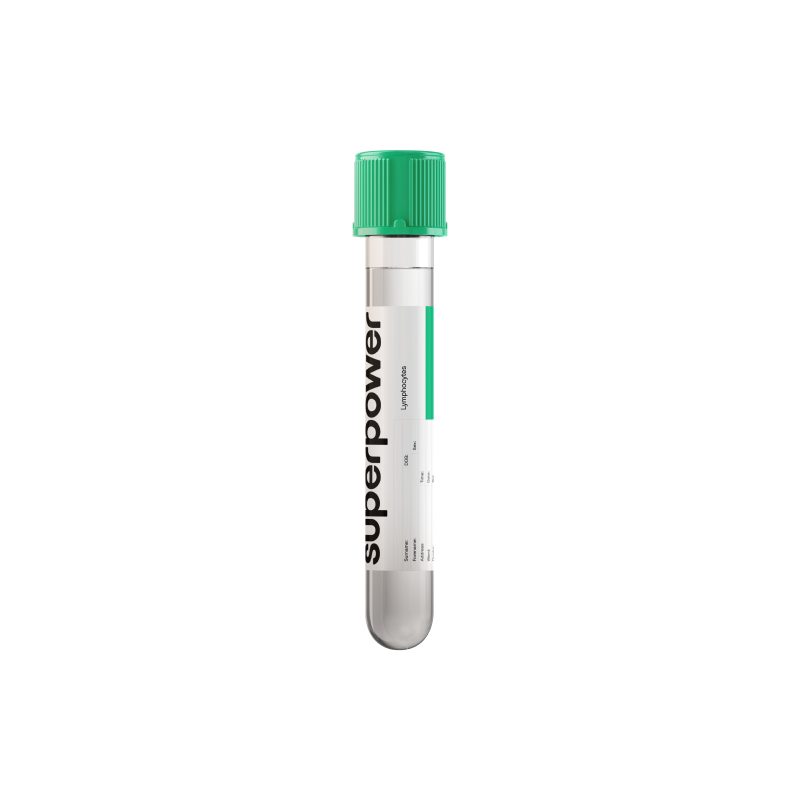Lymphocytes are a central component of your adaptive immune system. They include T cells, B cells, and natural killer (NK) cells, which coordinate responses, produce antibodies, and eliminate abnormal cells. A lymphocyte count is reported as part of a Complete Blood Count (CBC) with differential. The result reflects how many lymphocytes are circulating in your blood at a given time.
Balanced levels indicate immune stability and strong defense, while persistently low or high levels can reveal increased infection risk, immune activation, or more serious conditions. Tracking trends over time provides a more reliable picture than one result alone.
Key Benefits
- Check immune cell levels to gauge your body’s infection-fighting capacity.
- Spot viral patterns when lymphocyte counts run high during acute or recent infections.
- Flag low counts that increase infection risk and suggest immune deficiency or suppression.
- Can help contextualize fevers, lymph node swelling, or fatigue alongside exam and other labs.
- Guide targeted workups for HIV, autoimmune disease, or leukemia when results are concerning.
- Track recovery after infections, steroids, or chemotherapy by watching counts return to baseline.
- Support pregnancy safety by flagging low counts that heighten infection risks.
- Best interpreted with total white cells, neutrophils, and your symptoms.
What is Lymphocytes?
Lymphocytes are a family of white blood cells made in the bone marrow that populate the blood and lymphoid organs. They arise from immature precursor cells in the marrow (hematopoietic stem cells) and develop into three main types: B cells, T cells, and natural killer cells (NK cells). T cells complete their education in the thymus, B cells mature in the bone marrow, and NK cells mature in blood and tissues. These cells circulate between the bloodstream and lymph nodes, spleen, tonsils, and gut‑associated lymph tissue, standing guard throughout the body.
Lymphocytes are the core of targeted immune defense and immune memory (adaptive immunity). B cells make antibodies that tag microbes for removal (immunoglobulins). T cells coordinate responses and directly destroy infected cells (helper and cytotoxic T lymphocytes). NK cells provide rapid, non‑specific killing of virus‑infected or abnormal cells (innate cytotoxicity). Together, they recognize specific threats, eliminate them efficiently, and “remember” them after infections or vaccines. The lymphocyte measure on a blood test reflects the size and activity of this immune cell pool and the body’s ongoing surveillance against infections and abnormal cells (immune surveillance).
Why is Lymphocytes important?
Lymphocytes are the body’s adaptive defense specialists—T cells, B cells, and natural killer cells—that recognize threats, remember them, and coordinate precise responses. They patrol blood and lymph nodes, shape vaccine protection, keep viruses in check, and help prevent abnormal cell growth from taking hold.
In most healthy adults, lymphocytes make up about one‑fifth to two‑fifths of circulating white blood cells, with optimal immune steadiness sitting near the middle of that range. Children normally run higher, especially in early years, while pregnancy often shows a mild relative dip due to immune tolerance and blood-volume changes. Minor sex differences exist but are small compared with age and health effects.
When levels run low, it signals strained or suppressed adaptive immunity—after acute illness, high cortisol states, malnutrition, certain medications, or bone‑marrow or lymphoid disorders. The result is vulnerability to respiratory and skin infections, slower vaccine responses, mouth ulcers, poor wound control, and reactivation of latent viruses like shingles. Older adults with persistent lymphopenia may experience more infections and frailty; children may have recurrent infections and growth setbacks if deficits are significant.
When levels run high, the immune system is typically activated—most often by viral infections or pertussis, sometimes smoking or chronic inflammation. Nodes and spleen can enlarge, with fatigue, fever, night sweats, or weight loss. If elevations are sustained, especially in older adults, clonal processes such as chronic lymphocytic leukemia become a consideration.
Big picture: lymphocytes integrate nutrition, hormones, stress signals, and pathogen exposure. Tracked alongside neutrophils, the neutrophil‑to‑lymphocyte ratio, and inflammation markers, they offer a window into immune reserve, inflammatory balance, and long‑term risks from infection, autoimmunity, and hematologic disease.
What Insights Will I Get?
Lymphocytes measure the number of T cells, B cells, and natural killer cells in your blood. They are the backbone of adaptive immunity—identifying viruses and cancer cells, building immune memory, and coordinating inflammation. Because immune activity consumes energy and signals across tissues, lymphocyte levels reflect whole‑system balance affecting infection defense, recovery from illness, and the inflammatory tone linked to metabolic and cardiovascular health.
Low values usually reflect reduced production, increased destruction, or redistribution of cells (lymphopenia). This is common with acute physiological stress and cortisol exposure, severe infections, undernutrition, some autoimmune diseases, HIV, and immune‑suppressing drugs. System‑level effects include higher risk of viral and opportunistic infections and weaker vaccine responses. Older adults often run lower due to immunosenescence; during pregnancy, counts are often slightly lower as maternal immunity shifts toward tolerance.
Being in range suggests adequate immune surveillance without excessive activation. In adults, a mid‑range value typically indicates balanced defense, controlled inflammation, and effective tissue repair. Children’s healthy range sits higher than adults due to normal lymphocyte predominance in early life.
High values usually reflect immune activation (lymphocytosis). This is most often reactive, as with recent viral infections or other antigen exposure, and can accompany chronic inflammatory states. Persistent, marked elevations—especially in older adults—can indicate clonal lymphocyte expansion (such as chronic lymphocytic leukemia) that alters immune function.
Notes: Interpretation depends on absolute count more than percentage, since shifts in other white cells can change the proportion. Transient changes occur with infections, strenuous exercise, smoking, and medications (glucocorticoids lower counts). Children normally have higher values; elderly and pregnancy often trend lower. Repeat measurements and clinical context improve accuracy.



.svg)



.png)
.png)
.png)
.png)








